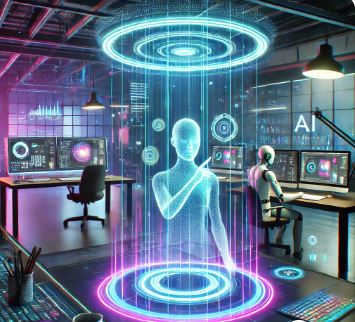
The year 2024 marks a profound moment in the evolution of creative industries, as advanced generative AI tools redefine what it means to create. From content generation and artistic endeavors to music composition and filmmaking, AI tools have become not just aids but partners in creativity. As companies like OpenAI, Meta, and others push the boundaries of what AI can do, the world of creative expression is experiencing a revolution that was once the stuff of science fiction.
Generative AI Tools: A New Frontier for Creatives
The power of generative AI lies in its ability to mimic human creativity. By using sophisticated models such as GPT-4 and Meta’s LLaMA 3, these systems are capable of generating original content, learning from vast amounts of data, and providing new insights. In essence, generative AI enables the creation of text, music, art, video, and even code, offering unprecedented opportunities for creators and businesses alike.
Let’s take a look at how generative AI is impacting specific creative fields:
1. Content Creation and Copywriting
Content marketing has witnessed an explosion of AI tools like ChatGPT, Jasper, and Copy.ai, which are now integral parts of writing blogs, creating ad copy, and even producing long-form content. These tools can generate human-like text, offering varied tones, styles, and languages, enabling businesses to automate large portions of their content creation processes.
The rise of multimodal AI systems, such as OpenAI’s DALL-E 3, which can generate both text and images, has also introduced a game-changing capability for marketers. Visual assets like advertisements, social media posts, and creative banners are now produced in record time by AI. Gone are the days when producing high-quality, engaging visuals was a laborious process requiring a full design team. Now, content creators can quickly generate assets that fit their vision perfectly, thanks to AI.
2. Music and Sound Design
Generative AI tools are also making significant inroads into music and sound design. Platforms like Soundraw and Amper Music allow users to generate unique musical compositions with minimal effort. By simply inputting the desired mood or style, AI can produce tracks that are not only original but also tailored to specific needs. These tools are being used in everything from film soundtracks to advertising jingles and even user-generated content on social media.
Music producers now have AI collaborators that offer new rhythms, melodies, and arrangements—elements that might have taken days to conceptualize before. This shift is democratizing music production, offering amateurs and professionals alike the ability to compose with an AI-powered creative assistant.
3. Visual Arts and Design
The world of visual art and design has seen some of the most impressive advances in AI-driven creativity. With platforms like DALL-E, MidJourney, and Meta’s generative models, artists can now co-create with AI. These tools allow for the generation of stunning artwork that can be fine-tuned or altered based on input from the creator. From logo design to fully realized digital paintings, AI has given both novice and seasoned artists access to new, more efficient methods of creation.
Art communities, particularly in fields such as digital art, are embracing these AI-driven tools to enhance creativity. With the ability to generate countless iterations of a concept in minutes, artists can focus on refining their vision, while the AI handles the more mechanical aspects of production.
4. Film and Video Production
The film industry, long reliant on visual effects and post-production technologies, is also benefiting from AI advancements. Tools like Runway and Descript are enabling creators to streamline the video editing process, while AI can now generate original visual effects, and even assist with scriptwriting and scene creation.
AI-powered software can simulate entire film scenes, predict character dialogue, and even create special effects that rival those of human designers. Directors and producers now have tools that can not only speed up production timelines but also open up new creative possibilities that were previously unfeasible due to time or budget constraints.
How Generative AI is Driving Innovation Across Industries
Beyond its immediate impact on creative industries, generative AI is driving innovation across multiple sectors:
- E-commerce: AI-generated content is now being used to create personalized product descriptions, marketing emails, and customer support solutions, improving engagement and reducing operational costs.
- Healthcare: AI is revolutionizing medical research and diagnostics by simulating biological processes and helping researchers understand complex data patterns more efficiently.
- Education: Tools like ChatGPT are being used to generate learning materials, personalized tutoring sessions, and even creative writing prompts for students, thereby making learning more interactive and personalized.
Predictions for the Future
As we look to the future, generative AI’s role in creative industries will only expand. Here are a few predictions based on current trends:
- Hyper-Personalization: By 2030, AI will be able to generate personalized content, music, and art that cater specifically to individual preferences, creating hyper-personalized experiences in digital entertainment, advertising, and content consumption.
- AI-Driven Virtual Worlds: The future of gaming and virtual reality will rely heavily on AI to create dynamic, evolving environments. AI will be able to generate entire worlds based on user input, allowing for limitless possibilities in virtual entertainment.
- Collaborative AI in Artistic Creation: AI will become an integral collaborator for artists. Instead of replacing human creators, AI will enhance and amplify their creativity by offering new ideas and possibilities that push the boundaries of what’s possible.
Sample Calculation: AI Impact on Content Creation Costs
- Traditional Content Creation Costs:
- Human Writer Salary: $40,000/year
- Time to Create 10 Blog Posts: 20 hours (at $20/hour = $400)
- AI-Powered Content Creation:
- AI Subscription: $100/month
- Time to Create 10 Blog Posts: 2 hours (AI generates first drafts, human edits)
- Savings:
- Human Cost: $400
- AI-Assisted Cost: $50 + $40 (human editing) = $90
- Total Savings per Batch: $310
This calculation shows how integrating AI can lead to substantial savings in content creation workflows, enabling businesses to scale their marketing efforts without additional manpower.


